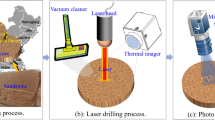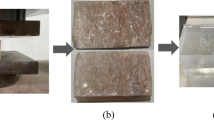Abstract
Coal mining is threatened by the aquifers below coal seams, and grouting is used to reconstruct the aquifers before mining. However, water gushing-out sometimes still occurs from the grouted aquifers. In this paper, two aspects of grouting in a vertical fracture are studied by numerical methods, including the slurry diffusion distance and the influence of grouting stone body on water inflow and water pressure. First, a grouting model consisting of a fracture and a borehole is proposed based on the hydrogeological conditions and grouting processes. Two hydrodynamic models controlled by the grouting stone body are established to study the variation of the water inflow and the water pressure in the filled section of the fracture. Then, the numerical calculation is carried out in detail. The numerical results show that the diffusion distance following the flow direction is significantly greater than the distance against the flow direction. The dynamic viscosity is successfully used to simulate the plugging effect of the grouting stone body. For a same fracture section, when the ratio of the maximum filled area to the fracture section area before grouting is less than 90%, the flow velocity presents an upward trend with the flow section decreasing due to the Venturi effect caused by the grouting stone. When the ratio of these two areas is more than 90%, the change of the flow velocity can be explained by the equal percentage characteristic of the valve. The data monitored by typical boreholes during grouting show that the water inflow and the water pressure both reduce after grouting or water inflow decrease and the water pressure keep unchanged after grouting, which is approximately in line with the fracture flow pattern controlled by the valve open degree. This study is conducive to the theoretical research of grouting engineering.












Similar content being viewed by others
Data availability
The data used to support the findings of this study are included within the article.
References
Andjelkovic V, Lazarevic Z, Nedovic V, Stojanovic Z (2013) Application of the pressure grouting in the hydraulic tunnels. Tunn Undergr Space Technol 37:165–179
Axelsson M, Gustafson G, Fransson Å (2009) Stop mechanism for cementitious grouts at different water-to-cement ratios. Tunn Undergr Space Technol 24(4):390–397
Bohloli B et al (2018) Strength and filtration stability of cement grouts at room and true tunnelling temperatures. Tunn Undergr Space Technol 71:193–200
Fransson Å, Tsang C, Rutqvist J, Gustafson G (2007) Estimation of deformation and stiffness of fractures close to tunnels using data from single-hole hydraulic testing and grouting[J]. Int J Rock Mech Min Sci 47:887–893
Funehag J, Gustafson G (2008) Design of grouting with silica sol in hard rock-New methods for calculation of penetration length, Part I. Tunn Undergr Space Technol 23:1–8
Gothäll R, Stille H (2010) Fracture-fracture interaction during grouting. Tunn Undergr Space Technol 25(3):199–204
Hernqvist L, Fransson Å, Gustafson G, Emmelin A, Eriksson M, Stille H (2009) Analyses of the grouting results for a section of the APSE tunnel at Äspö Hard Rock Laboratory. Int J Rock Mech Min Sci 46:439–449
Kociánová M, Drochytka R, Erný V (2016) Technology of remediation of embankment dams by optimal grout. Proc Eng 151:257–264
Lee J et al (2012) Analytical modeling and experimental verification of a tunnel with joint sets. Int J Rock Mech Min Sci 50:56–64
Lee J, Sagong M, Park J, Choi I (2020) Experimental analysis of penetration grouting in umbrella arch method for tunnel reinforcement. Int J Rock Mech Min Sci 130:104346
Li S, Liu R, Zhang Q, Zhang X (2016) Protection against water or mud inrush in tunnels by grouting: A review. J Rock Mech Geotech Eng 05:1–13
Liu X, Hu C, Liu Q, He J (2021) Grout penetration process simulation and grouting parameters analysis in fractured rock mass using numerical manifold method. Eng Anal Bound Elem 123:93–106
Lu Y et al (2017) Experimental study on the shear behavior of regular sandstone joints filled with cement grout. Rock Mech Rock Eng 50:1321–1336
Mohammed M, Pusch R, Knutsson S (2015) Study of cement-grout penetration into fractures under static and oscillatory conditions. Tunn Undergr Space Technol 45:10–19
Parl J, Song J (2013) Numerical method for the determination of contact areas of a rock joint under normal and shear loads. Int J Rock Mech Min Sci 58:8–22
Place J, Ghafar A, Malehmir A, Draganovic A, Larsson S (2016) On using the thin fluid-layer approach at ultrasonic frequencies for characterizing grout propagation in an artificial fracture. Int J Rock Mech Min Sci 89:68–74
Rafi J, Stille H (2015) Basic mechanism of elastic jacking and impact of fracture aperture change on grout spread, transmissivity and penetrability. Tunn Undergr Space Technol 49:174–187
Saeidi O, Stille H, Torabi S (2013) Numerical and analytical analyses of the effects of different joint and grout properties on the rock mass groutability. Tunn Undergr Space Technol 38:11–25
Salimian M et al (2017) Effect of grouting on shear behavior of rock joint. Int J Rock Mech Min Sci 98:159–166
Sui W, Liu J, Hu W, Qi J, Zhan K (2015) Experimental investigation on sealing efficiency of chemical grouting in rock fracture with flowing water. Tunn Undergr Space Technol 50:239–249
Tinoco J, Correia A, Cortez P (2011) Application of data mining techniques in the estimation of the uniaxial compressive strength of jet grouting columns over time. Constr Build Mater 25:1257–1262
Wang Y, Yang P, Li Z, Wu S, Zhao Z (2020) Experimental-numerical investigation on grout diffusion and washout in rough rock fractures under flowing water. Comput Geotech 126:103717
Yu B, Chen Z, Yu L (2016) Water-resisting ability of cemented broken rocks. Int J Min Sci Technol 26:449–454
Zheng C, Li B, Wu JW (2014) Indoor experimental study of clay-cement grout and its application in coal seam floor reconstruction by grouting. Geotech Investig Surv 3:5–10
Zhou F, Sun W, Shao J et al (2020) Experimental study on nano silica modified cement base grouting reinforcement materials. Geomech Eng 20(1):67–73
Zolfaghari A, Bidar S, Javan M, Haftani M, Mehinrad A (2015) Evaluation of rock mass improvement due to cement grouting by Q-system at Bakhtiary dam site. Int J Rock Mech Min Sci 74:38–44
Funding
This paper was supported by National Natural Science Foundation of China [Grant No. 52174181, 51504095]; the Fundamental Research Funds for the Central Universities [Grant No. 3142018021]. The authors are grateful to Jiaozuo Coal Industry Group for providing field testing sites.
Author information
Authors and Affiliations
Corresponding author
Ethics declarations
Conflict of interests
The authors declare that they have no known competing financial interests or personal relationships that could have appeared to influence the work reported in this paper.
Additional information
Publisher's Note
Springer Nature remains neutral with regard to jurisdictional claims in published maps and institutional affiliations.
Rights and permissions
About this article
Cite this article
Li, J. Numerical Study on Diffusion Distance and Plugging Effect of Grouting in a Vertical Fracture Under High Water Pressure. Geotech Geol Eng 40, 5497–5506 (2022). https://doi.org/10.1007/s10706-022-02228-0
Received:
Accepted:
Published:
Issue Date:
DOI: https://doi.org/10.1007/s10706-022-02228-0




